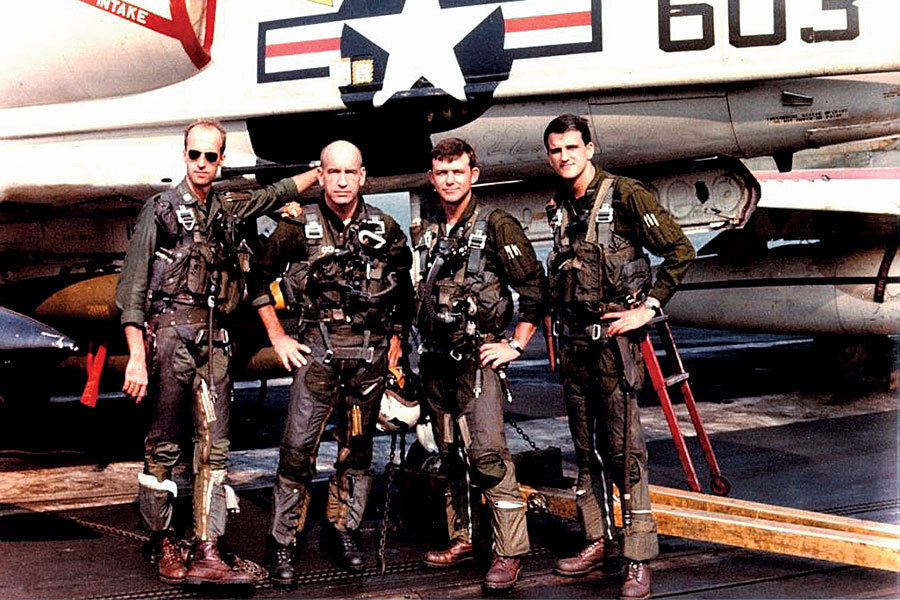McCain’s air war, and mine
Loading...
My first words over North Vietnam in 1968 were “Hey XO, they’re shooting at us.”
I was flying on the wing of squadron executive officer Marvin Naschek, both of us in Navy A-4 Skyhawk jets off the USS Coral Sea, and we had just crossed into enemy territory. “I know,” Commander Naschek said. “Keep moving.” It was a fraught conversation in just 10 words.
It was my first combat mission, and for a nanosecond or two, I had thought the gray puffs around us were fireworks. But no, it was antiaircraft fire. We jinked – changed heading and altitude every few seconds – in hopes of spoiling the North Vietnamese gunners’ aim.
I thought of that day when reading about the flap between Donald Trump and Sen. John McCain. Mr. Trump had implied that Senator McCain was not a war hero because he had been captured.
My Vietnam combat tour (1968-69) came at a relatively quiet period in the air war. President Lyndon Johnson hoped to get peace talks going by instituting a pause in the bombing over North Vietnam. So my squadron’s missions were limited to the area just below the demilitarized zone separating North and South Vietnam, although we often slipped into Laos, working with Air Force forward air controllers to attack trucks, storage areas, antiaircraft sites, and other military targets along the Ho Chi Minh Trail.
McCain had been shot down the previous year, when US air raids were directed at North Vietnamese targets around Hanoi and Haiphong Harbor.
While the opposition I encountered was sporadic and limited to “Triple A” (antiaircraft artillery), McCain faced MiG fighters as well as Russian-made surface-to-air missiles (SAMs), typically described as “flying telephone poles.”
Although the air defenses we faced were lighter, they were enough to prevent complacency. My squadron of about 20 aircraft and aviators lost four Skyhawks and two pilots. (The other two managed to eject over the water and were rescued by helicopter.)
The US military lost more than 300 A-4s in Vietnam – some to accidents, most to enemy action. I knew many of those lost, including two I’d roomed with – Dean Smith, shot down on his first mission, and Jim Dooley, who had been in McCain’s squadron on the USS Oriskany.
Jim Busey had been in that squadron as well, later commanding my squadron, then becoming a four-star admiral. Flying with McCain and Mr. Dooley, then-Lieutenant Commander Busey was awarded the Navy Cross for pressing his attack on a power plant as leader of a six-plane formation even though his jet had been severely damaged.
McCain’s last mission was similar, although the outcome was different. The target was a power plant in Hanoi. McCain knew he was being tracked by enemy radar, but he kept up his diving attack, pulling off target just as a SAM blew off one of the Skyhawk’s wings, sending him into an uncontrolled vertical inverted spin. Both his arms and a leg were fractured during his high-speed ejection.
After 5-1/2 years of captivity, which included torture and long periods of isolation, he was released along with 591 American POWs in March 1973.
I knew McCain, who was one of my flight instructors in 1965. He was a very demanding, sometimes abusive, teacher. Flight students – including me – dreaded flying with him. When I met him again years later, the first thing he said was “I’m sorry for the way I was then.” In his autobiography, he explains (while not justifying) his behavior as him being driven to see that his students survived combat.
What may be hard for civilians to understand – especially in this age of drone warfare – are the routine demands of flying then. The world McCain (and I) worked in could be extremely dangerous, even discounting combat.
Catapult launches and arrested landings – when the weather is good and everything in the aircraft is working properly – are almost routine. But never at night. I once had to be led down to a landing by another aircraft when I had lost my radios – at night and low on fuel. A fire on the USS Forrestal killed 134 sailors when a Zuni rocket misfired and struck the fuel tank on another jet.
A few months after that first combat mission on which I was his wingman, Naschek was catapulted off the Coral Sea at night. He never radioed a “Mayday,” but something happened – vertigo, perhaps, or an electrical failure – and he disappeared into the waters of the South China Sea.








